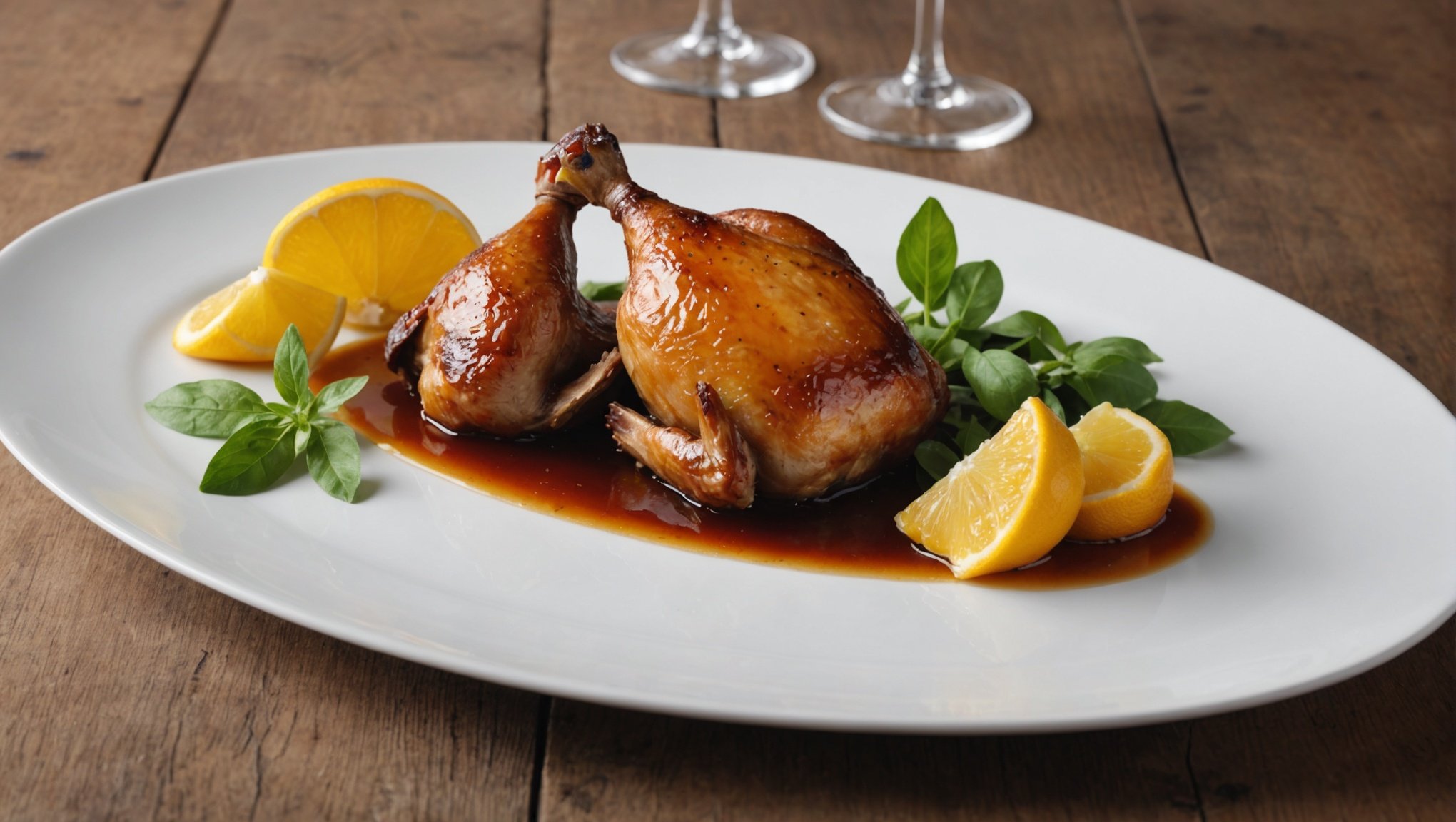Mastering the Art of Crispy Duck Confit with Zesty Citrus Glaze: The Ultimate Guide
Understanding the Basics of Duck Confit
Before we dive into the intricacies of creating a crispy duck confit with a zesty citrus glaze, it’s essential to understand the fundamentals of this classic French dish. Duck confit, originating from the southwest of France, particularly in the region of Gascony, is a method of slow-cooking duck legs in their own fat. This process not only makes the meat tender and flavorful but also preserves it, allowing it to be stored for several months.
The Traditional Method
Traditionally, duck confit involves salting the duck legs, then slow-cooking them in duck fat. Here’s a brief overview of the traditional steps:
Also read : Mastering the Art of Irish Beef Stew: Top Techniques for a Flavorful Guinness-Infused Dish
- Salting: The duck legs are rubbed with a mixture of salt, black pepper, and sometimes garlic and herbs, and left to cure for a few hours or overnight.
- Cooking: The cured duck legs are then submerged in duck fat and cooked at a low temperature (around 275°F or 135°C) for about 2-3 hours, or until the meat is tender and falls off the bone.
- Storage: After cooking, the duck legs are stored in airtight containers covered in the same fat used for cooking.
Modern Twists and Innovations
While the traditional method is still revered, modern chefs and home cooks have introduced several innovations to enhance the dish.
Sous Vide Method
One of the most significant modern twists is the use of sous vide cooking. This method involves sealing the duck legs in a bag with aromatics and then cooking them in a water bath at a precise temperature. Here’s how you can adapt the traditional recipe using sous vide:
Have you seen this : Mastering the Art of Creating the Ultimate Smoked Gouda and Apple Grilled Cheese Delight
- Preparation: Season the duck legs as you would traditionally, but instead of cooking them in fat, seal them in a sous vide bag with some aromatics like garlic, thyme, and bay leaves.
- Cooking: Cook the duck legs in a water bath at 130°F (54°C) for 48-72 hours. This ensures even cooking and retains the tenderness of the meat.
- Finishing: After the sous vide process, remove the duck legs from the bag and pat them dry. Then, sear them in a hot skillet with some duck fat to achieve a crispy skin.
Creating the Perfect Zesty Citrus Glaze
The zesty citrus glaze is what elevates the humble duck confit into a gourmet dish. Here’s how you can make a delicious and tangy glaze:
Ingredients
- 1 cup freshly squeezed orange juice
- 1/2 cup honey
- 1/4 cup Dijon mustard
- 2 tablespoons grated ginger
- 2 tablespoons lemon juice
- 1 tablespoon olive oil
- 1 teaspoon soy sauce (optional)
- Salt and pepper to taste
- Zest of 1 orange and 1 lemon
Preparation
- Combine Ingredients: In a saucepan, combine the orange juice, honey, Dijon mustard, grated ginger, lemon juice, olive oil, and soy sauce (if using).
- Reduce: Bring the mixture to a boil over medium heat, then reduce the heat to low and simmer until the glaze thickens and reduces by about half.
- Season: Season the glaze with salt, pepper, and the zest of the orange and lemon.
Assembling the Crispy Duck Confit with Zesty Citrus Glaze
Now that we have our duck confit and zesty citrus glaze, it’s time to bring everything together.
Steps to Achieve Crispy Skin
To achieve that perfect crispy skin, follow these steps:
- Pat Dry: After cooking the duck legs, pat them dry with paper towels to remove any excess moisture.
- Sear: Heat a skillet with some duck fat over high heat. Sear the duck legs until the skin is golden brown and crispy.
- Glaze: Brush the zesty citrus glaze over the duck legs during the last few minutes of searing to allow it to caramelize.
Serving Suggestions and Pairings
Duck confit is a versatile dish that can be served in various ways. Here are some ideas:
Classic Pairings
- Garlic Mashed Potatoes: A classic pairing that is both comforting and delicious.
- Roasted Vegetables: Roasted carrots, Brussels sprouts, or asparagus add a nice contrast in texture and flavor.
- Salad: A simple green salad with a light vinaigrette can provide a refreshing contrast to the rich duck.
Modern Pairings
- Saffron Rice: For a more exotic twist, serve the duck confit with saffron-infused rice and steamed vegetables.
- Quinoa Bowl: A quinoa bowl filled with roasted vegetables, avocado, and a drizzle of the zesty citrus glaze makes for a healthy and flavorful meal.
- Asian-Style Noodles: Serve the duck confit with stir-fried noodles, soy sauce, and sesame seeds for an Asian-inspired dish.
Practical Tips and Advice
Here are some practical tips to help you master the art of crispy duck confit with zesty citrus glaze:
Tips for Achieving Crispy Skin
- Dry the Skin: Ensuring the skin is completely dry before searing is crucial for achieving crispiness.
- High Heat: Use high heat to sear the duck legs quickly, which helps in achieving a crispy exterior.
- Don’t Overcrowd: Cook the duck legs one by one if necessary, to ensure each piece gets enough room to sear evenly.
Common Mistakes to Avoid
- Overcooking: Avoid overcooking the duck legs, as this can make the meat tough and dry.
- Insufficient Fat: Ensure there is enough fat to cover the duck legs during cooking, as this helps in keeping the meat moist.
- Not Reducing the Glaze: Failing to reduce the glaze can result in a thin, watery sauce instead of a thick, caramelized one.
Quotes from Chefs and Food Experts
Here are some insights from chefs and food experts on the art of making duck confit:
- “The key to a great duck confit is in the slow cooking. You want to cook it low and slow to ensure the meat is tender and falls off the bone.” – Chef Thomas Keller
- “A good zesty citrus glaze can elevate any dish. It adds a brightness and a depth of flavor that complements the richness of the duck perfectly.” – Chef Gordon Ramsay
- “Duck confit is one of those dishes that requires patience. But the end result is well worth the wait. It’s a true labor of love.” – Chef Jacques Pépin
Detailed Recipe and Ingredients List
Here is a detailed recipe for crispy duck confit with zesty citrus glaze:
Ingredients
For the Duck Confit:
- 4 duck legs
- 1 cup kosher salt
- 2 tbsp black pepper
- 2 tbsp garlic, minced
- 2 tbsp thyme, chopped
- 2 tbsp bay leaves, chopped
- 2 cups duck fat
For the Zesty Citrus Glaze:
- 1 cup freshly squeezed orange juice
- 1/2 cup honey
- 1/4 cup Dijon mustard
- 2 tbsp grated ginger
- 2 tbsp lemon juice
- 1 tbsp olive oil
- 1 tsp soy sauce (optional)
- Salt and pepper to taste
- Zest of 1 orange and 1 lemon
Instructions
- Prepare the Duck Legs:
- Rub the duck legs with the kosher salt, black pepper, garlic, thyme, and bay leaves.
- Let them cure for at least 2 hours or overnight.
- Cook the Duck Legs:
- If using the traditional method, submerge the cured duck legs in duck fat and cook at 275°F (135°C) for 2-3 hours.
- If using sous vide, seal the duck legs in a bag with aromatics and cook in a water bath at 130°F (54°C) for 48-72 hours.
- Make the Zesty Citrus Glaze:
- Combine the orange juice, honey, Dijon mustard, grated ginger, lemon juice, olive oil, and soy sauce (if using) in a saucepan.
- Bring to a boil over medium heat, then reduce the heat to low and simmer until the glaze thickens.
- Achieve Crispy Skin:
- Pat the cooked duck legs dry with paper towels.
- Sear the duck legs in a hot skillet with duck fat until the skin is golden brown and crispy.
- Brush the zesty citrus glaze over the duck legs during the last few minutes of searing.
Comparison Table: Traditional vs. Sous Vide Method
Here is a comparison table highlighting the differences between the traditional and sous vide methods of cooking duck confit:
| Aspect | Traditional Method | Sous Vide Method |
|---|---|---|
| Cooking Time | 2-3 hours | 48-72 hours |
| Temperature | 275°F (135°C) | 130°F (54°C) |
| Equipment Needed | Large pot or Dutch oven | Sous vide machine and vacuum sealer |
| Even Cooking | Risk of uneven cooking if not monitored closely | Ensures even cooking throughout |
| Tenderness | Can be tender but may vary depending on cooking time and temperature | Consistently tender and moist |
| Convenience | Requires constant monitoring | Hands-off once the duck is sealed and placed in the water bath |
| Storage | Must be stored in fat after cooking | Can be stored in the refrigerator or freezer after cooking |
Mastering the art of crispy duck confit with zesty citrus glaze is a journey that requires patience, attention to detail, and a bit of creativity. Whether you choose the traditional method or the modern sous vide approach, the end result is a dish that is both delicious and visually appealing. With these tips, recipes, and insights, you’re well on your way to creating a culinary masterpiece that will impress even the most discerning palates.
So, the next time you’re planning a special dinner or just want to treat yourself to something extraordinary, consider giving this recipe a try. Share your experiences and tips on social media using hashtags like #duckconfit #zestycitrusglaze #sousvide #cookingtips, and don’t forget to share your delicious creations on Facebook, Twitter, and Pinterest Happy cooking






